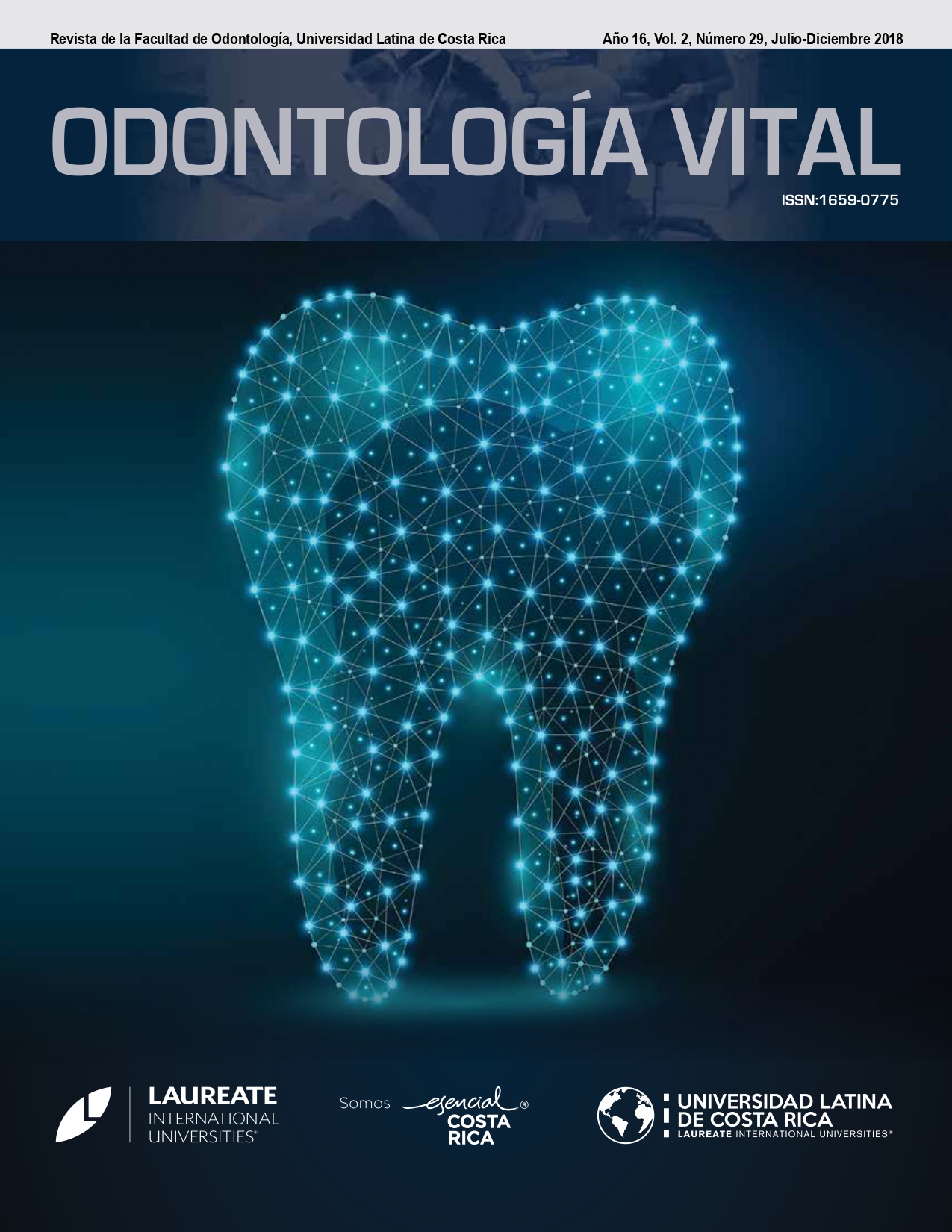Management of the patient with severe crowding and bilateral posterior cross bite with maxillaryexpander type Hyrax
DOI:
https://doi.org/10.59334/ROV.v2i29.149Keywords:
Skeletal class II, severe crowding, maxillary expansionAbstract
Causes of transverse discrepancies of the maxilla can be genetic or environmental. We present a patient of 17 years 7 months of age. In his clinical and radiographic analysis he was diagnosed as: Skeletal Class I, hyperdivergent, malocclusion class II bilateral molar and canine, bilateral posterior cross bite, severe upper and lower crowding, crossed dental organ. The treatment consisted of maxillary expansion and alignment, opening of space for 22, leveling, detailing and retention. The appliances used were brackets prescription Roth .022 x .028, maxillary expander type Hyrax, molar bands in the upper molars 6s, tubes in 6’s and 7’s upper and lower, open coil of Niti. The retention in charge of upper and lower circumferential retainer and a bonded retainer from 13- 23 and 33-43, time of active treatment 1 year 11 months.
Downloads
References
Bros, T., Vardimon, A.D., . Ergatudes, C., Spiegler, A., Lieberman, M. (1998). Rapid palatal expansión. Part 3: strains developed during actuve and retention phases. Am J Orthod Dentofacial Orthop ;114:123-33. https://doi.org/10.1053/od.1998.v114.a85568
Christie, KF., Boucher, N., Chung, Ch. (2010). Effects of bonded rapid palatal expansion on the transverse dimensions of the maxilla: A cone-beam computed tomography study. Am J Orthod Dentofacial Orthop ;137:S79-85. https://doi.org/10.1016/j.ajodo.2008.11.024
Ciambotti, C., Ngan, P., Orthh, C., Durkee, M., Kohli, K., Kim, H. (2001), A comparrison of dental and dentoalveolar changes between rapid palatal expansion and nickel-titanium palatal expansion appliances. Am J Orthod Dentofacial Orthop ;119:11-20. https://doi.org/10.1067/mod.2001.110167
Da Silva FOG., Boas, MC., Capelozza, FL. (1991). Rapid maxillary expansion in the primary and mixed dentitions: a cephalometric evaluation. Am J Orthod Dentofacial Orthop ;100(2):171-9. https://doi.org/10.1016/S0889-5406(05)81524-0
Davidovitch, M., Efstathiou, S., Sarne, O., Vardimonc, AD. (2005). Skeletal and dental response to rapid maxillary expansión with 2- versus 4- band appliances. Am J Orthod Dentofacial Orthop ; 127: 483-492. https://doi.org/10.1016/j.ajodo.2004.01.021
Haas, AJ. (1965). The treatment of maxillary deficiency by opening the midpalatal suture, Angle Orthod; 35: 200-217.
Haas, AJ. (1961). Rapid Expansion of the Maxillary Dental Arch and Nasal Cavity by Opening the Midpalatal Suture, Angle Ortho 196131:73-89.
Harvold, EP., Chierici, G., Vargervik, K. (1972). Experiments on the development of dental malocclusions. Am J Orthod ;61:38-44. https://doi.org/10.1016/0002-9416(72)90174-1
Isaacson, RJ., Ingram, A.H. (1964). Forces produced by rapid maxillary expansion. Angle Orthod ;34:261-90.
Lampasso, JD., Lampasso, JG. (2004). Allergy, Nasal Obstruction, and Occlusion. Semin Orthod ;10:39-44. https://doi.org/10.1053/j.sodo.2003.10.003
McNamara, JA., Brudon, WL. (1993). Orthodontic and Orthopedic Treatment in the Mixed Dentition. Ann Arbor European Journal of Orthodontics, Volumen 16, Número 1, 1 de febrero de 1994 Páginas 82-83
Oliveira, NL., Da Silveira, AC., Kusnoto, B., Viana, G. (2004). Three dimensional assessment of morphologic changes of the maxillary: A comparasion of two kinds of palatal expanders. Am J Orthod Dentofacial Orthop ;126:354-62. https://doi.org/10.1016/j.ajodo.2003.07.008
Proffit, WR. (2008). Contemporary Orthodontics. 2da edición Barcelona: Elservier capítulo 5. Pp 130-161.
Ramoglu, SI., Sari, Z. (2010). Maxillary expansion in the mixed dentition: rapid or semi-rapid? Eur J Orthod Feb;32(1):11-8. https://doi.org/10.1093/ejo/cjp057
Timms, DJ. (1986). The effect of rapid maxillary expansion on nasal airway resistance. Brit J Orthod 13:221-28. https://doi.org/10.1179/bjo.13.4.221
Zimring, JF., Isaacson, RJ.. (1965), Forces produced by rapid maxillary expansion. Part III. Forces present during retention. Angle Orthod ;35:178-86.
Downloads
Published
Issue
Section
License
Copyright (c) 2018 Stefanny Espinosa Holguín, Beatriz Gurrola Martínez, Adán Casasa Araujo

This work is licensed under a Creative Commons Attribution 4.0 International License.
Authors who publish with Odontología Vital agree to the following terms:
- Authors retain the copyright and grant Universidad Latina de Costa Rica the right of first publication, with the work simultaneously licensed under a Creative Commons Attribution 4.0 International license (CC BY 4.0) that allows others to share the work with an acknowledgement of the work's authorship and initial publication in this journal.
- Authors are able to enter into separate, additional contractual arrangements for the non-exclusive distribution of the Odontología Vital's published version of the work (e.g., post it to an institutional repository or publish it in a book), with an acknowledgement of its initial publication.
- Authors are permitted and encouraged to post their work online (e.g., in institutional repositories or on their website) prior to and during the submission process, as it can lead to productive exchanges, as well as earlier and greater citation of published work.







